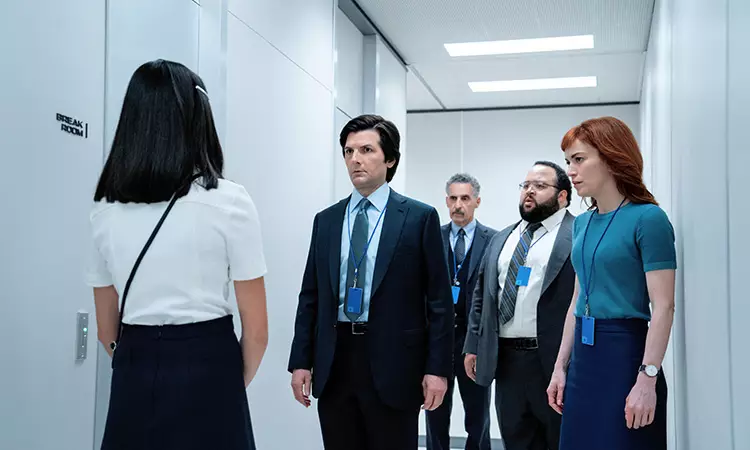In an era where professionals often grumble about their mundane 9-to-5 jobs, Dan Erickson’s conception of “Severance” emerges as a profound commentary on the human condition and the extremes to which we might go to avoid dissatisfaction. The Apple TV+ series not only entertains but prompts viewers to contemplate the value of memories and experiences at work versus personal life. Erickson recalls a pivotal moment that spurred the show’s creation, expressing a wish to simply fast-forward through his workday, avoiding the ennui of routine. This desire, he realizes, is deeply unsettling, a reflection of how some individuals might perceive their existence within the confines of corporate culture.
The central narrative follows Mark Scout, portrayed by Adam Scott, and his colleagues at Lumon Industries, who undergo a “severance” procedure. This fictional surgical operation splits their memories, creating a chasm between their identities at work and their personal lives. It’s a striking metaphor for a generation grappling with the pressures of professional demands and the desire for personal fulfillment. Erickson’s initial dread of entering the office resonates with anyone who has felt trapped in roles that stifle their essence.
As “Severance” progresses, it unfolds an intricate web of mysteries surrounding Lumon Industries and its enigmatic practices. Each episode nudges viewers closer to understanding the company’s true motives while posing essential questions about identity and autonomy. What compels these characters to choose such an unconventional dissociation? The theme of self-disconnection resonates deeply, prompting us to ponder not only the reasons behind the characters’ decisions but also our own relationship to work.
The show’s first season culminates with the main characters rebelling against the severance process, challenging the confinement of their identities. This defiance represents a quest for self-discovery, which is a fundamental struggle faced by many in today’s work environment. Erickson’s narrative resonates with anyone who has ever yearned to break free from constraints and uncover the broader tapestry of their existence.
One of the facets that primarily drew viewers into the emotional depth of “Severance” is the layered backstories of the characters. While the series predominantly features four individuals, audiences are initially left craving more knowledge about their lives outside the insulated walls of Lumon. Erickson acknowledges the creative process behind these characters, noting he developed intricate backstories that shape their motivations and decisions.
In crafting these narratives, Erickson collaborates with notable figures like Ben Stiller and Mark Friedman, allowing for a confluence of ideas that breathe life into the story. Each character’s choice to undergo severance is imbued with personal tragedy, sadness, and complexity, emphasizing that such decisions arise from profound discontent rather than mere whim.
As the storyline pivots into the second season, viewers are promised a deeper dive into each character’s backstory, revealing insights that have been discreetly bubbling under the surface. The tension between their severed identities and reality raises a critical question: what does it mean to truly know oneself?
With season two on the horizon, the stakes are elevated. Creator Dan Erickson hints at an expansion beyond the sterile confines of Lumon. The transition to explore the employees’ lives outside of work promises to unveil the intricate relationship between their work identity and their overall personal narrative. By exploring this duality, the series not only heightens the emotional stakes but also invites viewers to engage in a broader discourse regarding work-life balance.
Specifically, the ambiguous nature of Lumon creates an intriguing dynamic that blurs the lines between corporate and cult-like behavior. Reflecting on this duality, Erickson emphasizes the complexity of the organization, satisfying viewer curiosity while planting the seeds for further questions. As the narrative unfolds, audiences will be compelled to dissect the fabric of their own workplaces and the often hazy boundaries that define their professional identities.
In the realm of audiences dissecting every minute detail, Erickson finds himself caught in a delightful web of fan theories and artistic expressions inspired by the show. His joy is palpable, yet there’s an air of caution. He admits to sometimes being wary of consuming fan theories, aware that differing interpretations can influence his creative direction. Yet, the fervor surrounding the show is undeniable, with fans eager to solve the puzzles presented in every episode.
“Severance” is more than a work of fiction; it is a rich tapestry that invites audiences to explore deep-seated human fears and desires. Overall, as viewers anticipate the unraveling of its secrets in Season Two, they carry not just a sense of curiosity but also introspection about their roles in a world that often prioritizes productivity over personal fulfillment. Ultimately, Erickson and his team not only entertain—they invite us to ponder the essence of our own identities within and beyond the walls of our everyday realities.

